Carlo Ancelotti picked up three trophies this season.
Even still, it’s not the season the defending European and La Liga champions hoped for.
After a down year, Barcelona stormed back to retake the La Liga crown and Real Madrid experienced a humiliating defeat at the hands of Manchester City in the Champions League. Los Blancos came up blank in the two competitions they valued most.
Winning just three trophies in a single year can only be disappointing for the likes of Real Madrid, especially when the Champions League or La Liga titles are not one of the trophies claimed. The jury is still out on the consequences of a relatively disappointing season. Arrivals and departures are rumoured, including links to Ancelotti’s future.
This data analysis will look at what went wrong in Madrid. We’ll use statistics and data visualisations to identify key differences from last season’s wildly successful campaign to this season. Player performances will factor into this analysis as well. And finally, since no team is an island, we will also look at how Real Madrid fared against La Liga this year and the number one threat to reclaiming the domestic title, the resurgence of Barcelona.
Teamwide patterns and statistics
Let’s start with a look at differences from the team perspective. We want to look at how this season’s attacking patterns compare to last year, and also look at defensive metrics. Those defensive metrics will include transitional moments, particularly the effectiveness of the counterpress.
A common criticism this season was that Vinícius Júnior accounted for too much of the creative load. The Brazilian forward had another excellent year and was the most dangerous player in the club. Among players with at least 500 minutes played, Vini’s 10.93 dribbles P90 rank second behind Osasuna’s Ez Abde (13.27), who only played 624 minutes over 10 matches. Safe to say that no one carried as much of his team’s attacking burden as Vinícius Júnior did in 2022/23.
The ball progression map reflects Real Madrid’s dependence on #20. Though Vinícius Júnior still carried much of the attacking burden last year, the load only seems to have increased in 2022/23. By attacking burden, we are specifically targeting progressive actions that carry the team into the final third and into the box. In the opposition’s half of the field, no player was as important to Real Madrid’s final third attacking side than the Brazilian.
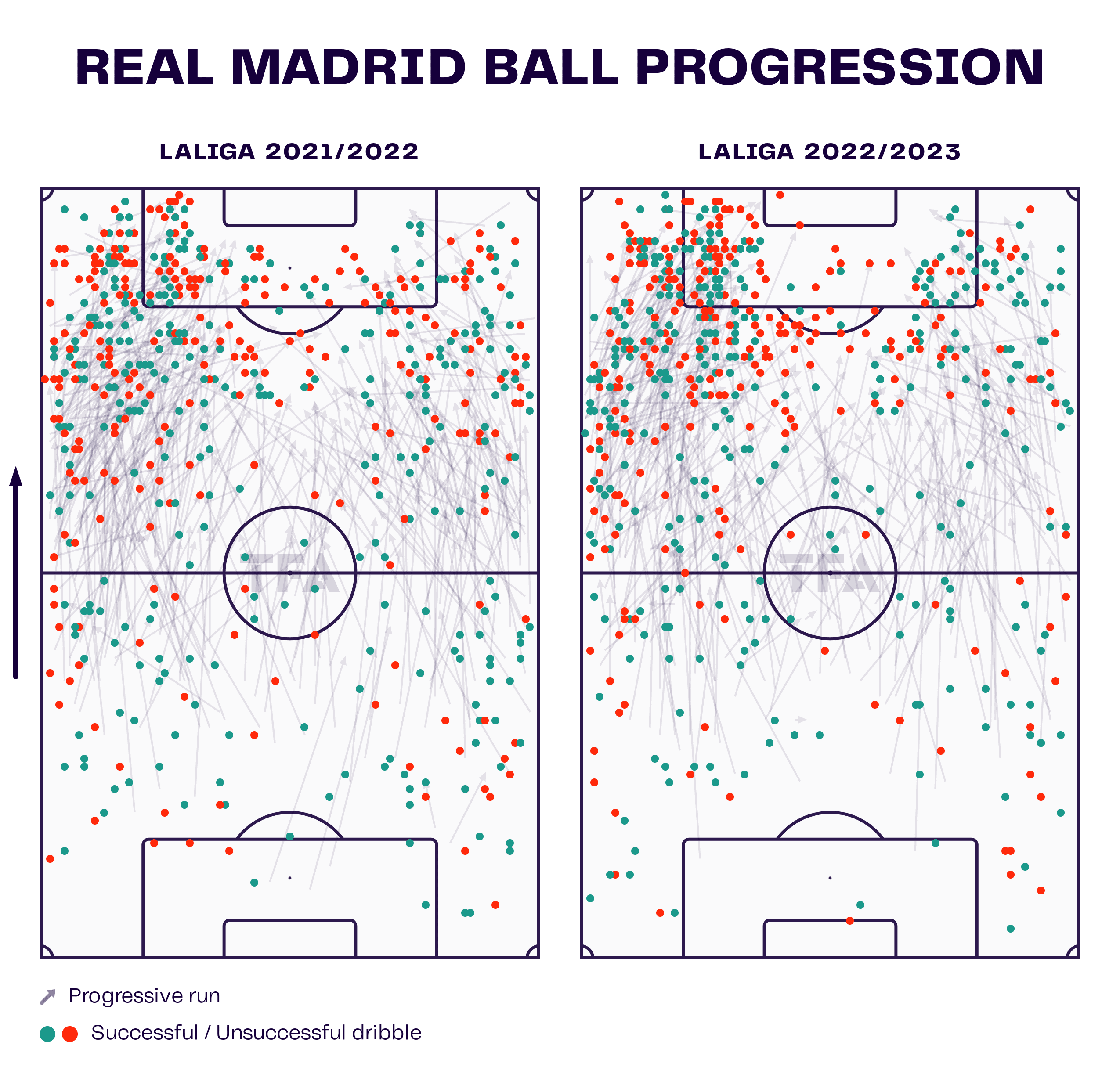
But with such extreme dependence on a single player’s individual brilliance, attacks become more predictable. Opponents could find ways to limit the damage inflicted by Vini. Whether that was sitting deeper or committing a second (or third) defender to the ball, containing Vinícius Júnior’s threat was each opponent’s top priority.
Predictability in attack wasn’t the only issue Real Madrid encountered this season.
One of the major storylines this season was the age of Real Madrid’s midfield. Luka Modrić turned 37-year-old and Toni Kroos 33 during the 2022/23 campaign. The club sold then-30-year-old Casemiro to Manchester United and replaced him with the young Aurélien Tchouaméni from Monaco. Given the development of Fede Valverde, Eduardo Camavinga and Rodrygo, there was an assumption there would be greater rotation in midfield and less of a need for the Uruguayan in the forward line.
Ultimately, Modrić and Kroos still received the bulk of the minutes while Valverde alternated between the midfield and forward lines, Camavinga between midfield and left-back and Tchouaméni between the defensive midfield role and the bench. Though Real Madrid’s midfield seems set for the next five-plus years, the lack of rotation would seem to indicate the future is not yet upon us.
To some degree, you can understand Ancelotti’s conundrum. Given the roles Modrić and Kroos have played during their Real Madrid tenures and the success the club had just last season, there is an element of “don’t fix what ain’t broke.”
Defensively, Casemiro’s absence and Tchouaméni’s limited playing time placed even greater strain on the veteran midfielders defensively. Looking at Real Madrid’s high regains map for the previous season and the current campaign, we do find that Real Madrid had fewer high regains and far fewer counter-pressing recoveries. Dangerous recoveries increased by eight, but counterpressing recoveries could decrease by as many as 65 by the end of the season.
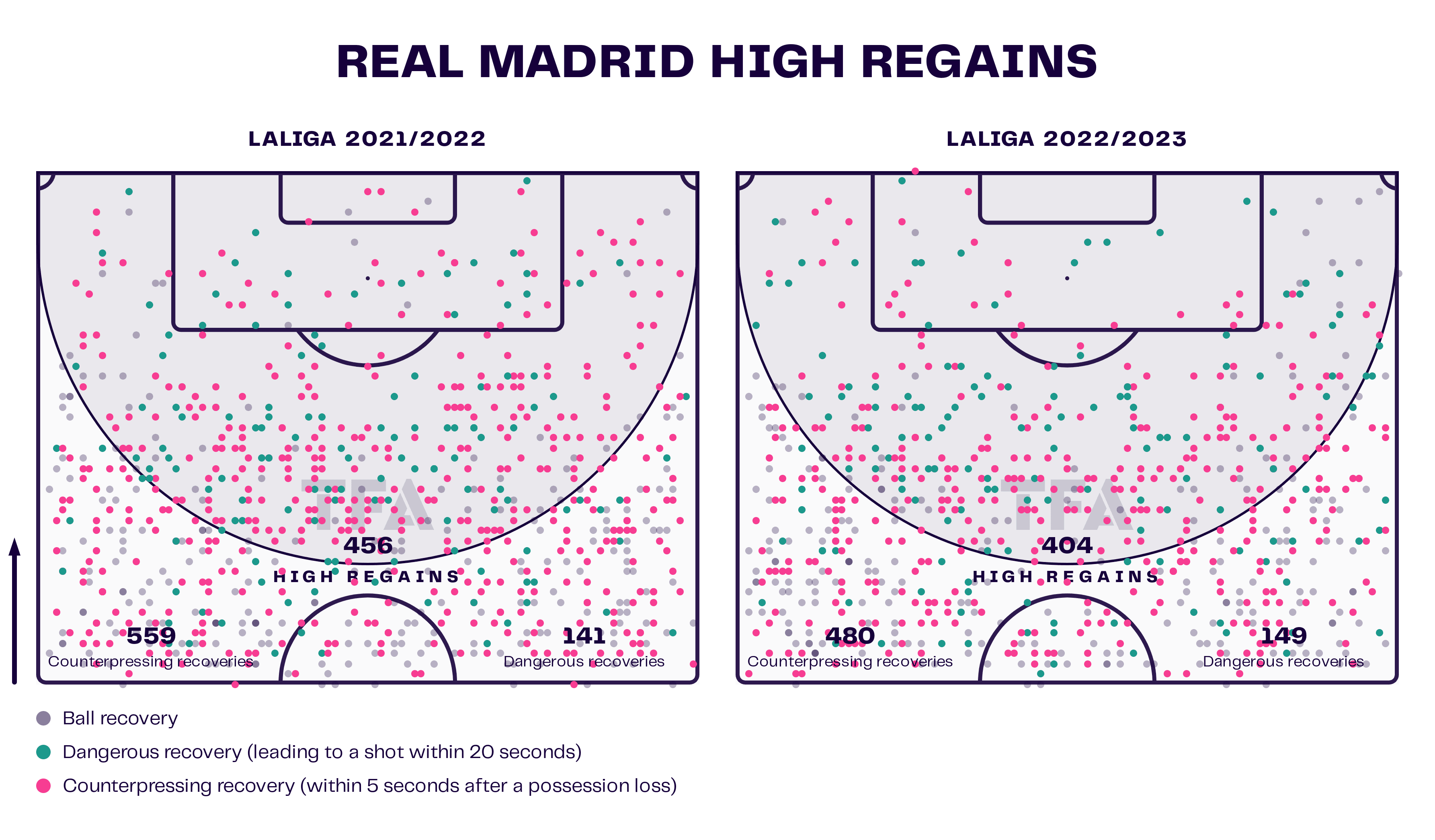
The poor counterpressing isn’t necessarily caused by the ageing midfielders, but it is a reflection that more help was needed in midfield. A ball-winner to simplify the roles of Kroos and Modrić would have helped significantly, as would more rotation, especially after a mid-season World Cup, the toll of which was discussed in a previous data analysis.
Adding to the issues were injuries to David Alaba and Ferland Mendy. The mix-and-match backline, which frequently included Camavinga at left-back, ranks fifth in La Liga in xGA (42.12).
Further complicating the issue was that Thibaut Courtois regressed. His shots faced map shows each attempt he faced in the run of play the past two seasons. Though he has actually seen a decrease in XG faced, Courtois’ prevented goals have dropped from 9.93 to 2.51. Many points are tied up in that 7.42 difference.

His radars from the past two seasons shed more light. At least in the save categories, Courtois was in the 93rd percentile in three of the five.
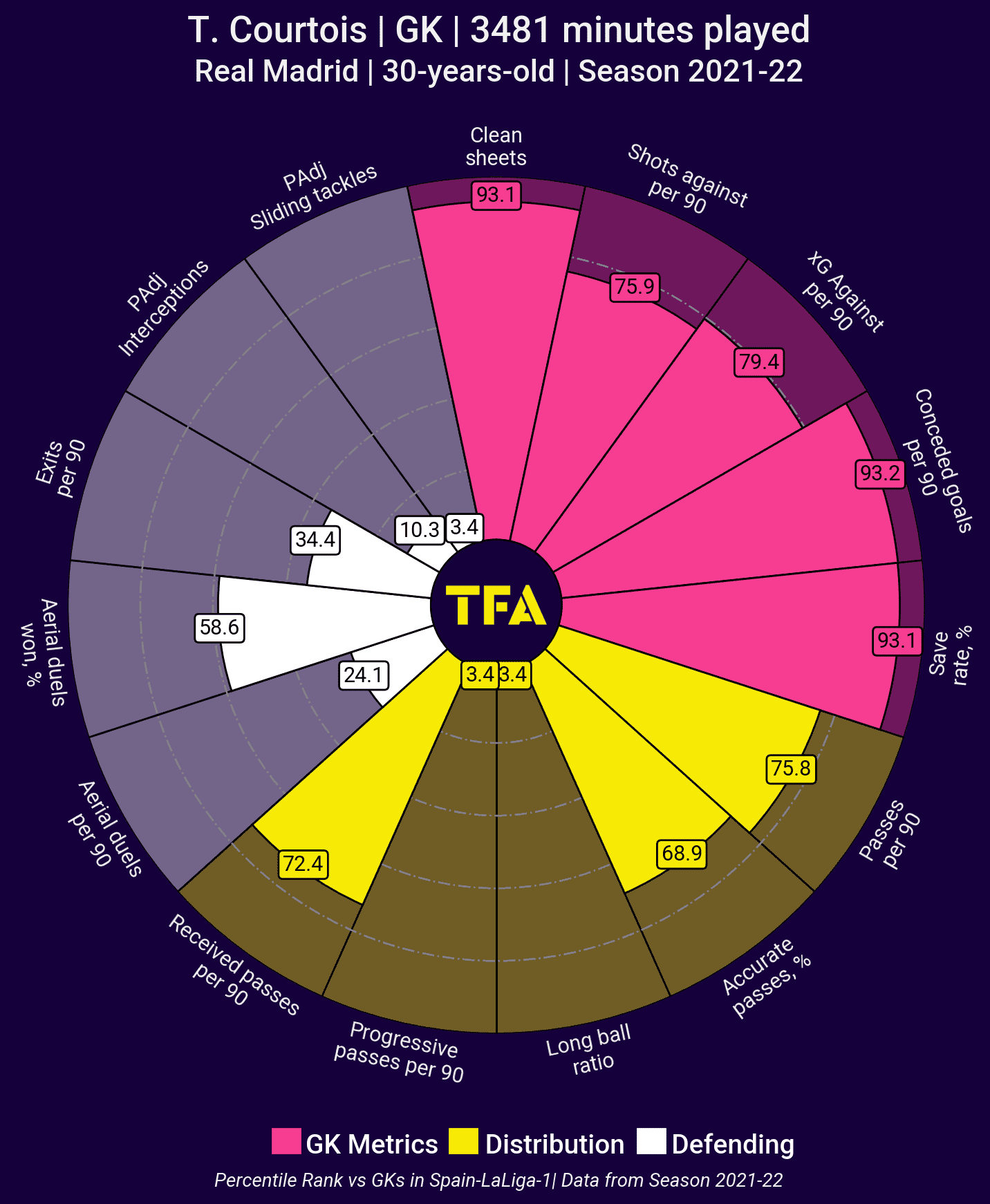
Fast forward to this year and his personnel ratings ranged from 72nd to 78th. Those are significant declines for any player, but especially for a goalkeeper. When a keeper’s statistics decline, the result is more goals in the back of the net. That’s difficult for any team to recover from.
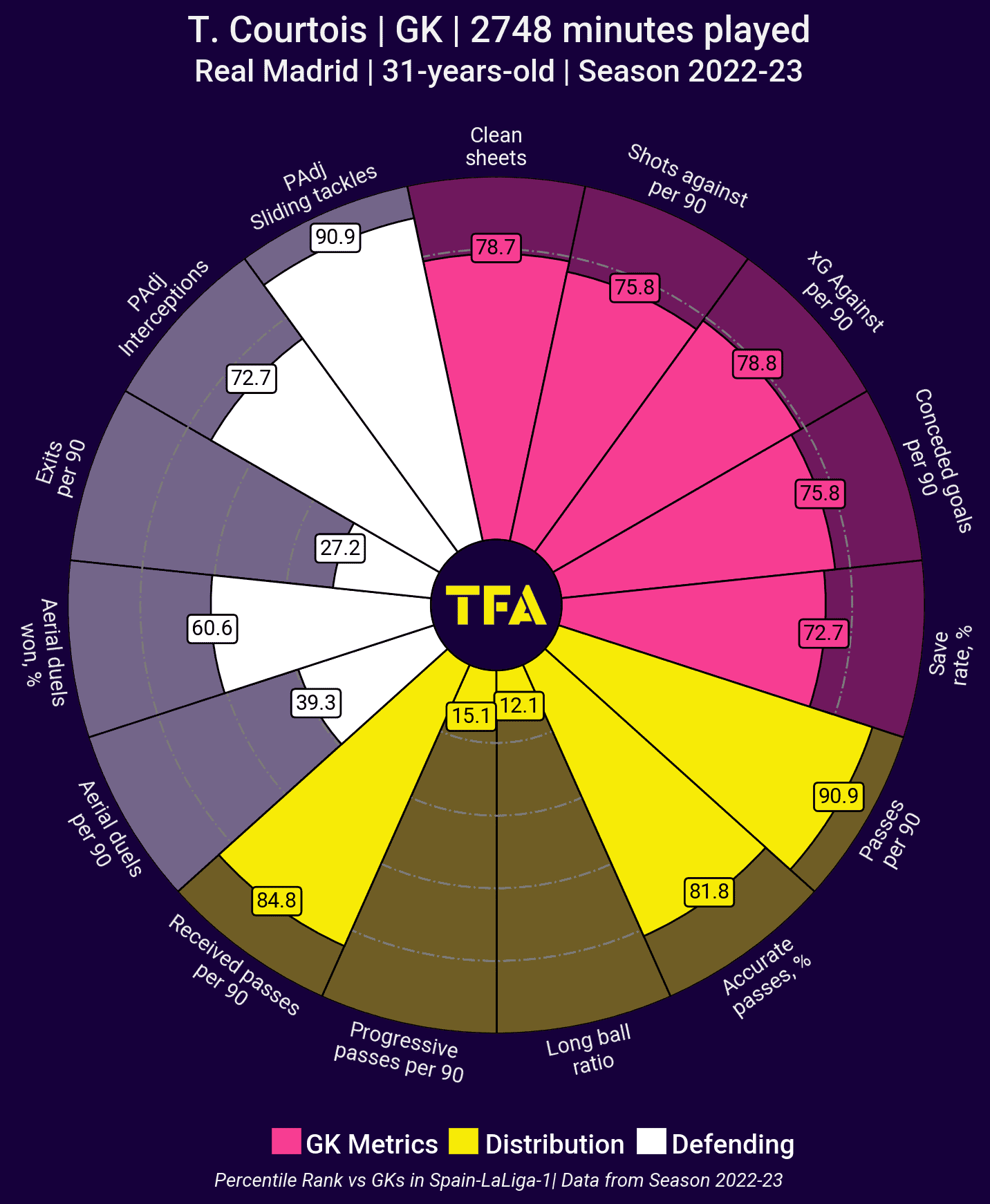
With an idea of some of the more prevalent issues from a team perspective, we’ll dive deeper into individual performances.
Differences in player performances
Since we’ve already covered the goalkeeping issues, this section will focus on the first two issues presented in the previous section. First, we have Real Madrid’s dependence on Vinícius Júnior. That includes an investigation into Karim Benzema’s production as well.
Perhaps the best way to investigate this issue is to compare radars from the previous two seasons, just as we did with Courtois. Again, it’s the pink metrics that are 90th percentile or better. He was scoring goals, making key passes and terrorising opponents on the dribble. Vini also rated well in the passing statistics with that yellow colour code while benefiting from a lesser workload defensively. What is important to note on the defensive side is that teams with more of the ball simply defend less, which is part of the reason he has lower percentile ratings there despite being exceptional in defensive duels.
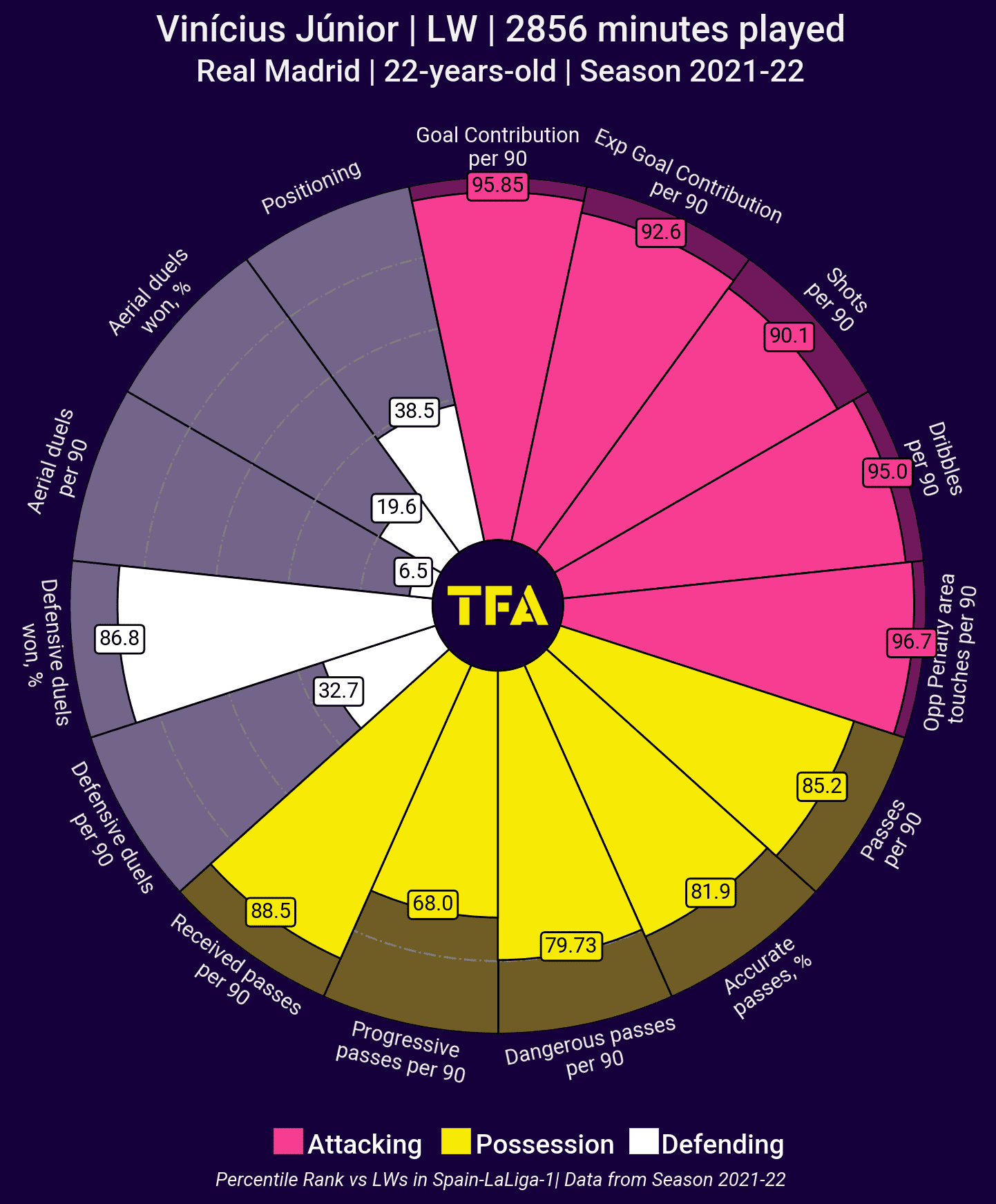
Looking at the season, we do see a drop in gold contributions P90, expected goal contributions P90 and shots P90. Vinícius was also less involved in the defensive tactics, often forming a two-man front with Benzema. Perhaps the most troubling aspect of the radar is the drop in efficiency with his passing.
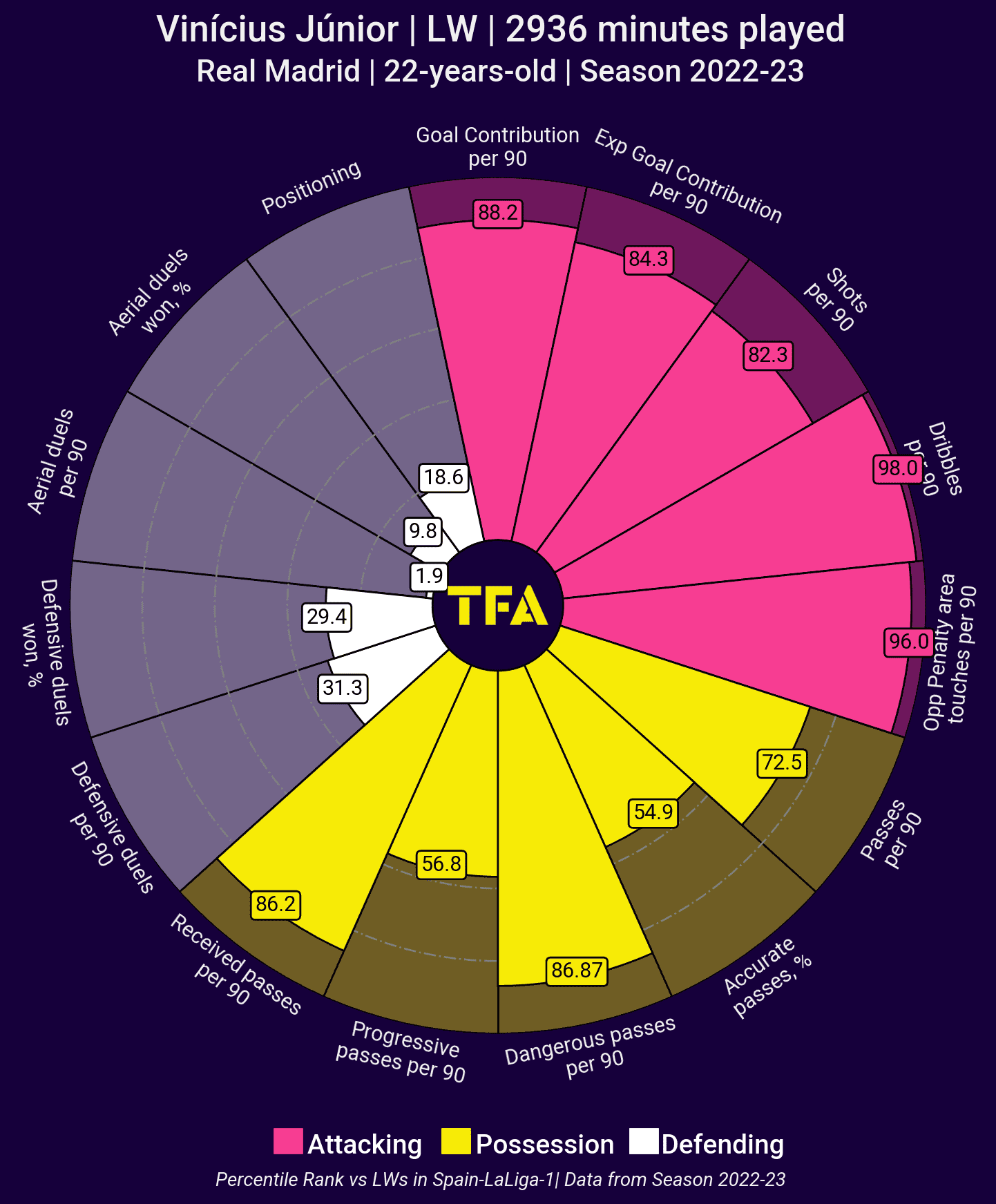
What that signals is just how often Vinícius received the ball, put his head down and engaged the opponent with the dribble. And that wasn’t necessarily the wrong decision either. Oftentimes, he was isolated on the left. That was Real Madrid’s way of giving him a 1v1 duel and letting him run at an opponent with space to attack. It’s the perfect setup for a dynamic player like Vinícius Júnior. That said, it also signals a one-dimensional attack.
While Vinícius suffered a decline in the box, he wasn’t the only one. Benzema has seen his goal tally drop, as well as the number of shots he has taken. Looking at the XG per shot, he’s actually seen an improvement this year, which should result in more goals, not fewer. Either way, the two players Real Madrid depend upon most for their goals suffered this season.
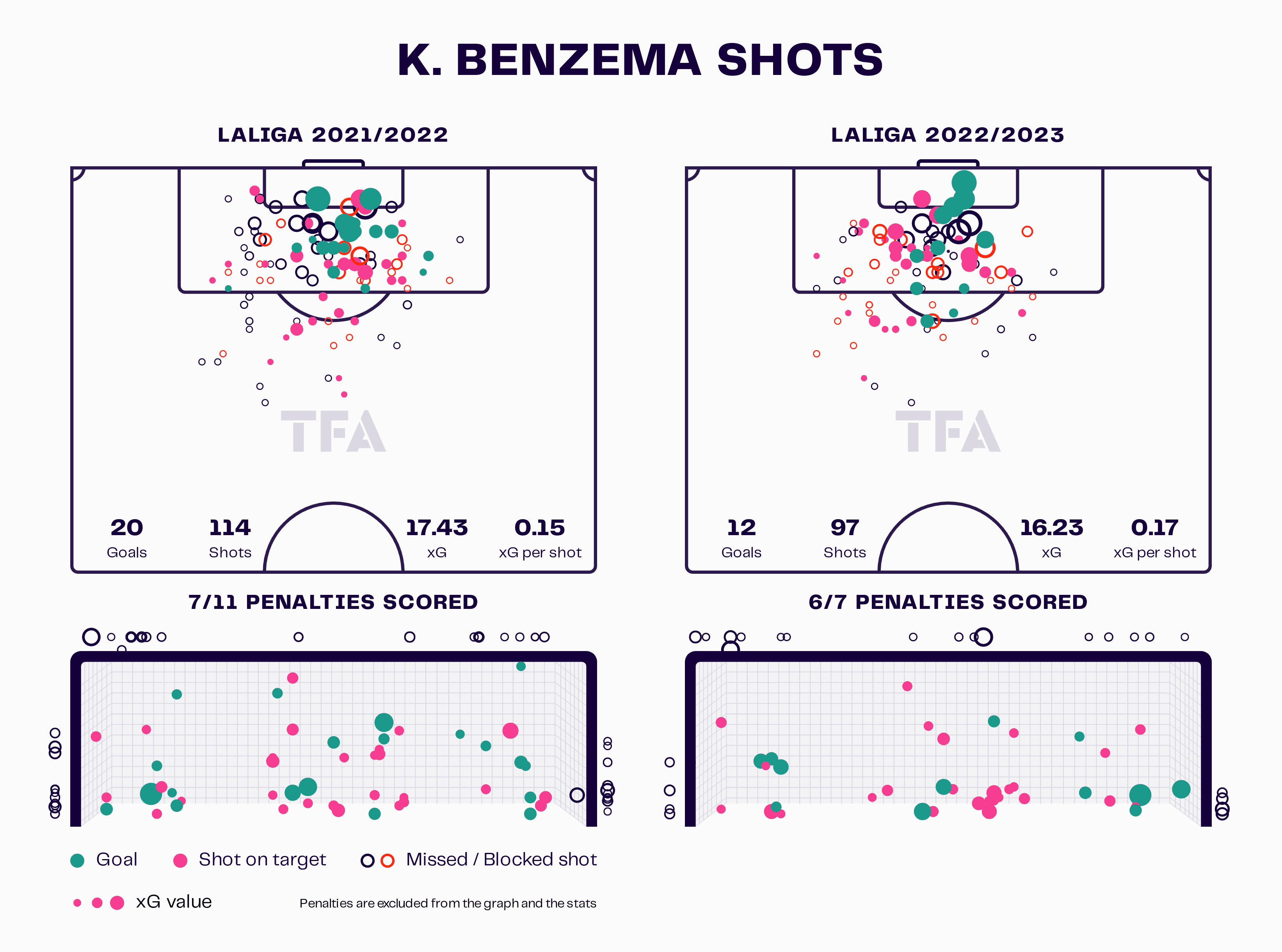
Let’s turn to that second issue, which is the lack of defensive security in midfield. Selling Casemiro to Manchester United was a sign that the club intended to move on, that Tchouaméni was ready to take the Brazilian’s role in the Real Madrid midfield. Though he started the season well, the young Frenchman faded and lost his starting role, receiving few minutes per game in the second half of the season. Casemiro’s radar, especially the percentile ratings indicated by the white markings, show us exactly what Real Madrid lost.
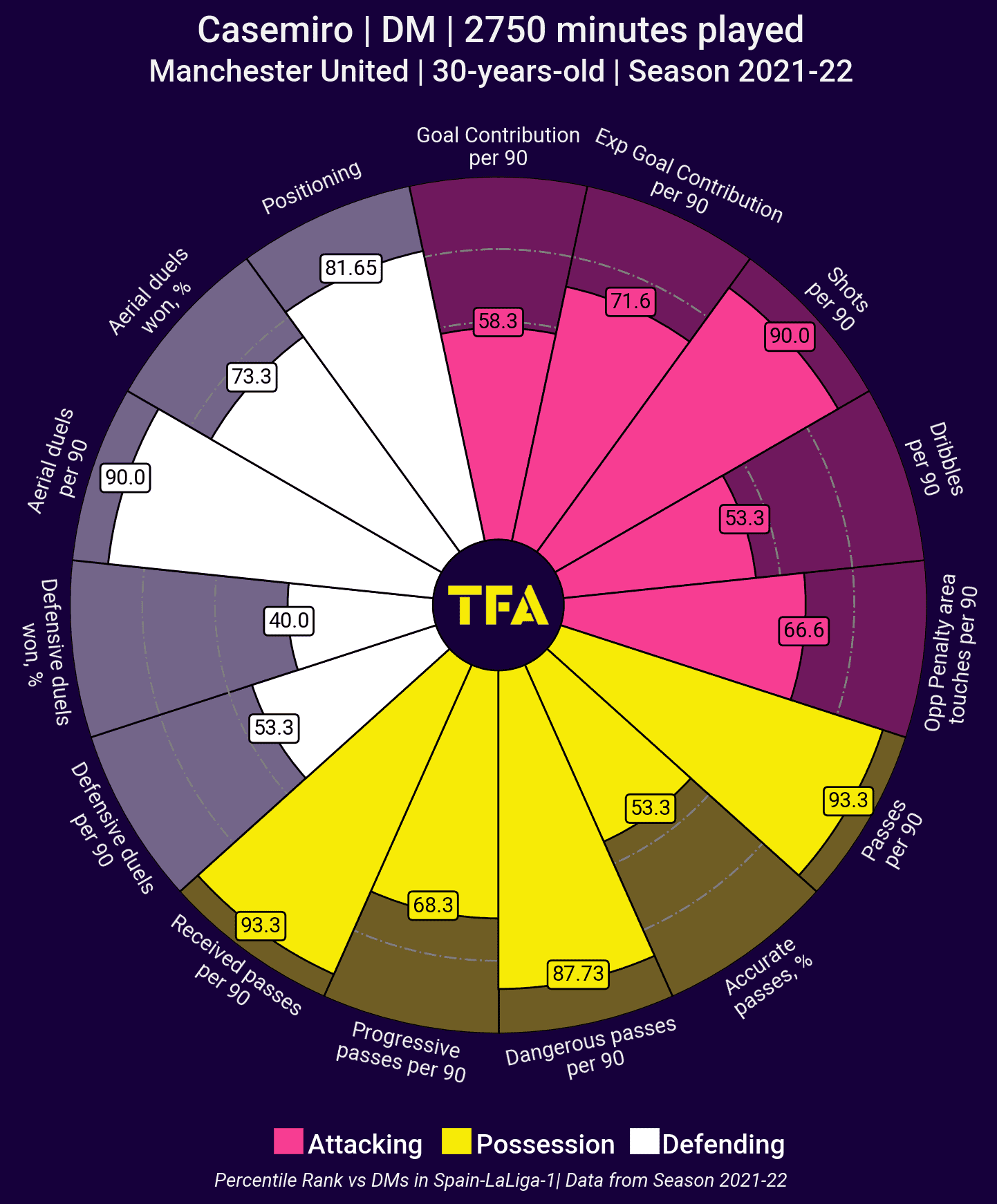
With the Brazilian out of the lineup and the young Frenchman struggling for minutes, Kroos often played a deeper role. It is a role he has played in the past, but certainly not one that maximises his unique skill set or gives the team adequate protection defensively. While Kroos is a competent defensive player, he’s best suited to play next to a ball-winner.
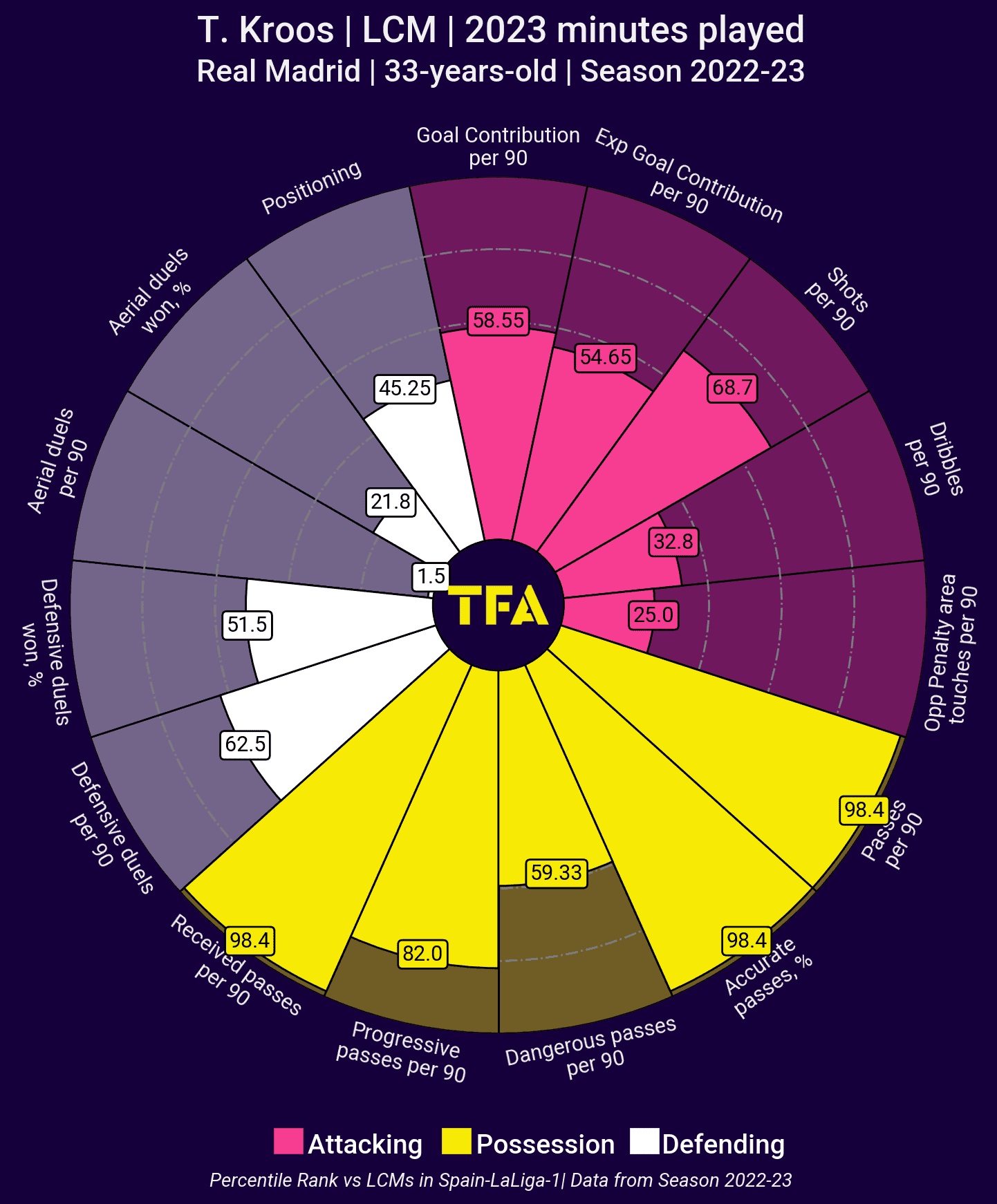
Real Madrid thought they had replaced Casemiro with their defensive midfielder of the future, Tchouaméni, but the future has not yet arrived. Kroos often had to handle the role, which dropped either Valverde or Camavinga into midfield. Granted, both are reasonably talented defensive players, but Casemiro was a special talent, a world-class one, whose production was simply not accounted for.
The Barcelona problem
Real Madrid may very well improve upon the 2022/23 campaign next season. They may perform better in all relevant statistics, yet that’s no guarantee of titles. Improvement is necessary, but that improvement is not just in comparison to their own concrete metrics. We also have to account for the resurgence of Barcelona.
It’s not enough to assume that catching Barcelona’s production from the 2022/23 campaign is the target. Xavi will be in his second year with the club and the players now have a full year together, so there should be more fluidity in next season’s performances. If Real Madrid wants to reclaim their crown, their improvement has to be relative to Barcelona’s anticipated production levels.
Looking at the current campaign, Real Madrid was the top-performing side in terms of xG. Given the decline of Vinícius Júnior and Benzema, there is room for improvement in this category. Real Madrid should expect to score more goals next year.
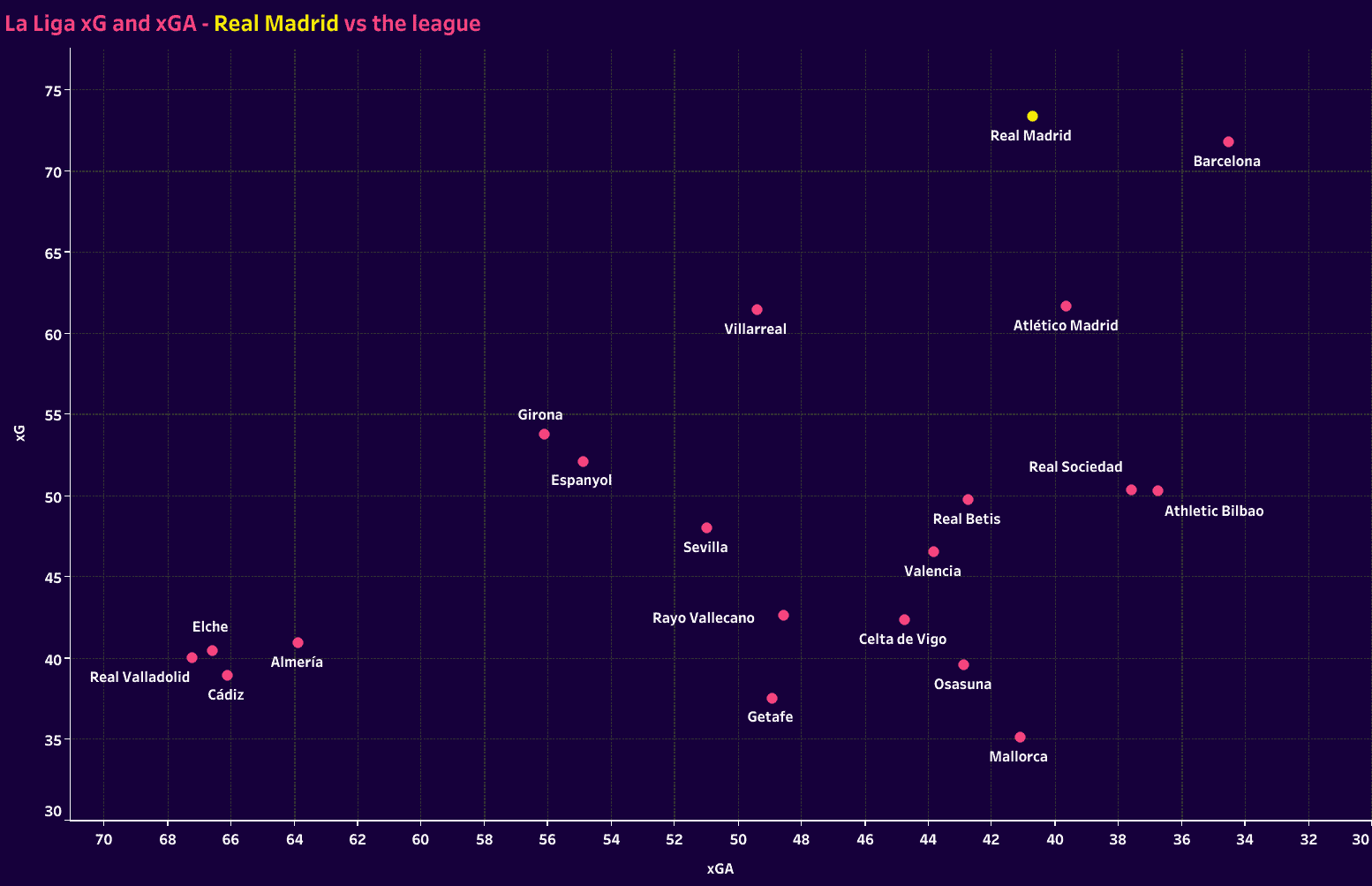
The bigger issue will be the team’s defensive frailties. Though 40.73 xGA (through the first 36 games) isn’t terrible, it’s still enough to fall fifth in La Liga. Barcelona’s conceded goals were far lower than their 34.53 xGA, so they should see a regression to the mean next season, but Real Madrid has to make some ground here. Courtois returning to his typically high standards will help, but better organisation and counterpressing will go a long way.
With these last two charts, we’ve plotted data relating Real Madrid and Barcelona’s previous two campaigns, both from a results perspective and in terms of how the two sides constructed play.
For Real Madrid, we do find slight decreases in goals and xG per game. The points per game total may look like a slight decline, but over 38 games, that drop from 2.26 to 2.06 leads to a total of 7.6 points. That may not be enough to catch Barcelona, but it gives us a race until the end of the season. For Real Madrid, they may not have to look any further than the increase in the number of goals against per game, which is coupled with the decrease in xGA per match. That’s a troubling relationship.
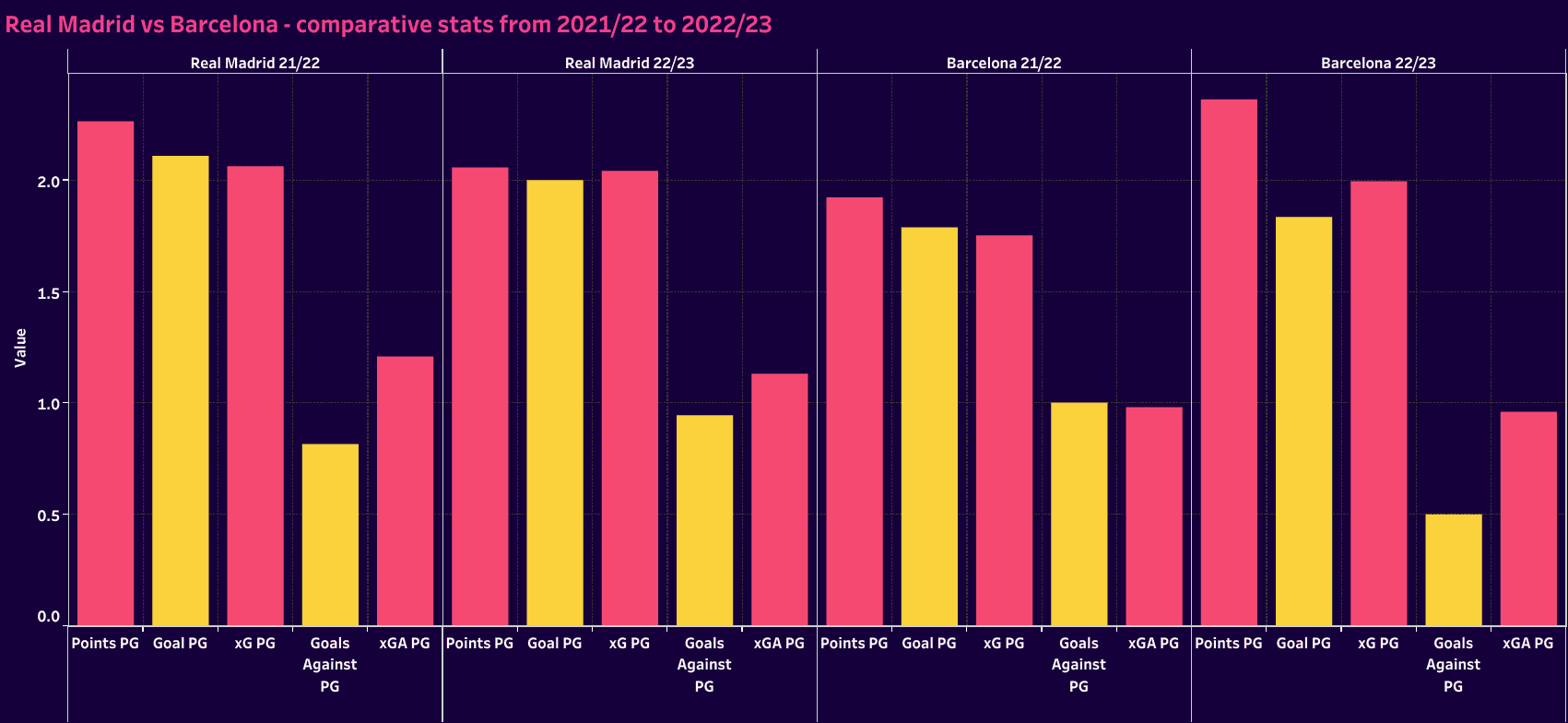
For Barcelona, xG per game went up and goals against went way down. Interestingly enough, goals scored had a very small increase and xGA per game was roughly the same. There is an element of luck to Barcelona’s defensive record. Take nothing away from Marc-André ter Stegen, who had a fantastic year, but Barcelona’s defensive statistics are unsustainable. Expect a regression next season, which will help Real Madrid’s cause.
The final image plots how the two teams constructed play. Ultimately, there was very little variation in how the two sides approached the game. The most likely difference between the two seasons was the degree of execution.
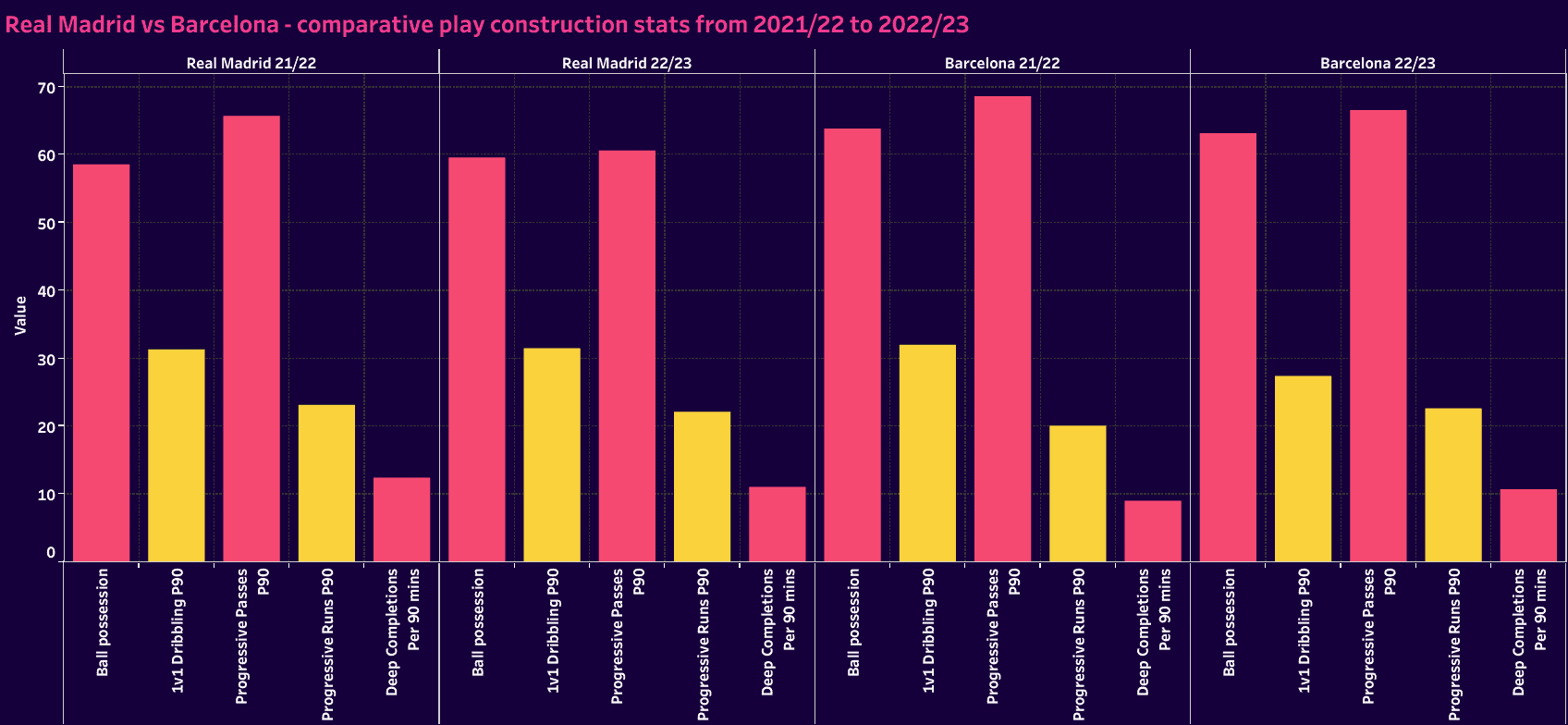
There will always be some variability in team and player performances, so executing tactics will always have a degree of irregularity. Given the talent in this Real Madrid squad and the peculiarity of a mid-season World Cup, wholesale changes do not seem necessary. Instead, a few adjustments to tactics and personnel seem to be the greatest needs.
Conclusion
Real Madrid has some work to do, but this is certainly not a time for panic.
Barcelona’s defensive metrics are simply unsustainable. Expect a regression there. As they concede more goals they’ll drop more points, helping the Real Madrid cause.
From Real Madrid’s perspective, more attention to the midfield succession plan is likely needed, as well as decreasing the dependence on Vinícius Júnior’s 1v1 attacking. Correcting the poor seasons for Benzema and Courtois, at least by their lofty standards, will go a long way as well.
Within the next few weeks, we should have a better idea of Ancelotti’s fate, as well as some of the anticipated transfer activity. Several players are headed for an exit and there are rumours that limited players will come into the squad. Real Madrid Castilla has had a fine season, so there may be some internal promotions in line, but next season’s fate will still rest squarely on the core group of players currently in the squad.
This wasn’t the campaign Real Madrid wanted, but calm heads and slight adjustments are the greatest needs for next season.

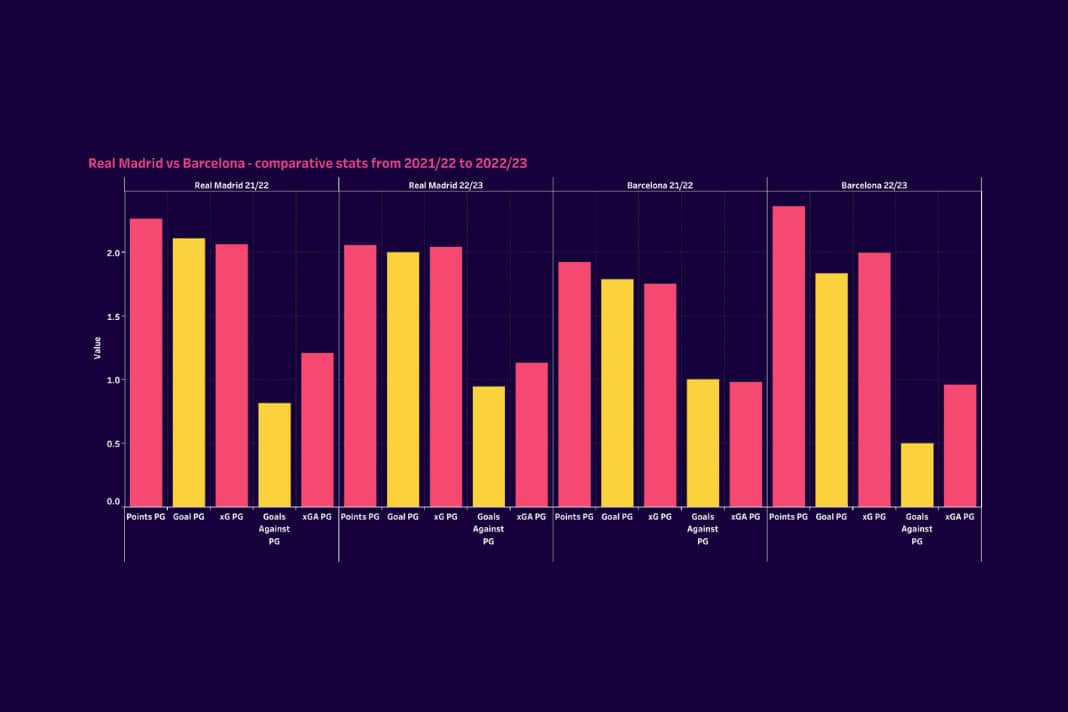



Comments